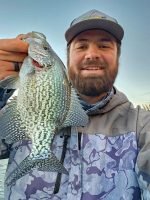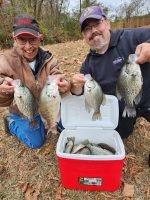One of Capt. Josh Antwine’s clients with proof-positive that there are great numbers, and great size crappie to found fishing the tailwater area downstream from Chickamauga Dam on the Tennessee River. Capt. Antwine says find pockets protected from the current can actually make it easier to locate crappie. (Photo: Capt. Josh Antwine)
Tailrace Crappie Catching
by Brent Frazee
Heavy current usually isn’t conducive to catching crappie – unless that current includes areas where obstacles slow or eliminate the current. In those cases, it can actually be much easier to figure out where the crappie are.
Capt. Josh Antwine with Chattahookem Fishing Charters in Chattanooga, Tenn. and Cody Vannattan with Cody’s Bait & Tackle Guide Service in Warsaw, Missouri have both learned to capitalize on that for their clients.

Antwine spends most of the year guiding for bass on the Tennessee River, fishing almost exclusively downstream from Chickamauga Dam – an area which almost always has significant current flowing. Vannattan guides for big blue catfish and hybrid stripers on Missouri’s Truman Reservoir and Lake of the Ozarks.
But they share a common goal and strategy when water is being released through the dams in their respective areas.
They know the shad will be thick in the tailraces they fish. And they know there’s a good chance schools of big crappies will be there gorging on that fast food.
“From mid-November through January, which is typically our rainy season, we’ll have excellent crappie fishing below these dams,” said Capt. Antwine. “It’s all about the current.”
Vannattan says the same thing.
“When (the U.S. Army Corps of Engineers) release water through Truman Dam, a lot of shad will move up,” said Vannattan. “That’s when you want to be out there fishing.”
Below Chickamauga Dam
Capt. Antwine discovered the crappie fishing in the Lake Chickamauga tailwaters as a way to avoid the crowds.

“I got tired of all the fishing pressure on Chickamauga Reservoir (upstream from the dam),” he said. “By the second week of December, every dock, every brush pile that holds crappie had been hit hard. I wanted to come up with something different.”
That’s when he started fishing below Chickamauga Dam, the headwaters of Nickajack Lake on the Tennessee River. In the winter, there is consistent current due to water releases to generate hydroelectric power or occasionally for flood control.
Antwine says big schools of threadfin and gizzard shad are attracted to that moving water. And the crappies set up in predictable calm water spots to ambush those roaming baitfish.
“I’m always looking for a place where those crappie can escape the current,” Capt. Antwine said. “Eddies and current seams are good places. I look for something blocking the current, like a rock jetty, a mooring buoy, a brush pile, big rocks—any slack water off the main current where those crappie can stack up.”
Because Capt. Antwine has fished the Chickamauga tailwaters for so long, he knows where most of the sweet spots are, although they can vary greatly depending upon the amount of water being released through the dam.
“With it being a current-based fishery, the crappies below Chickamauga Dam are pretty easy to pattern,” Antwine said. “They’ll go to the same places every year. It’s not like I have to go out and relocate them every year.”
Antwine likes to cast Bobby Garland plastic baits on jig heads ranging in weight from 1/8th of an ounce all the way down to 1/64th.
He uses a 6-foot-6 medium -light ACC Crappie Stix rod and a Daiwa Revros spinning reel, which he said gives him the sensitivity to detect light strikes, the power to fight big fish in the current, and the ability to make long casts.
Below Truman Dam
Vannattan remembers Truman Dam’s early days when he could scramble down the riprap below the dam and cast into the swirling, frothy current and catch limits of big crappie.

If the fishing in the current wasn’t good that day, he could go over the hill and fish the deadwater channel that was created when the Osage River was dammed, and catch crappie there. He says those days in the early 1990s, when Truman Dam was still relatively new (construction was completed in 1979), were the glory years.
The baitfish in Lake of the Ozarks grew accustomed to migrating upstream whenever there was current, and the crappie ate until they were full.
Today, water releases through the U.S. Army Corps of Engineers dam are not as consistent, and neither is the fishing. But make no mistake, the Truman tailwater can still produce outstanding fishing.
On spring days, the deadwater channel often is full of boats, with fishermen reeling in crappie at an impressive clip.
Below the dam itself, which is restricted to bank fishing, fishermen regularly find success below swirling eddies and current seams.
Vannattan likes to fish from a boat below the off-limits area and cast plastic baits or use slip bobbers in the slack water off the current.
Below Truman Dam, it’s not so much a seasonal fishery. In other words, you can’t circle a week on your calendar and say that’s the week to go. Rather, it’s all related to water releases and current, Vannattan said.
Because west-central Missouri gets a lot of rain in April and May, chances are good that there will be moving water in those months. But periods of heavy rain or need for generation of electricity can create heavy releases at other times of the year as well.
Vannattan, who owns Cody’s Bait and Tackle near the dam, keeps tabs on the fishing below the dam as well as anyone. When the Corps is running water, business will pick up. Fishermen will show up wanting to buy minnows or plastic jigs and grubs.
“When the water’s running, all different species will be up there feeding,” Vannattan said. “It’s a good place for a mixed bag. But a lot of people go for the crappie. It’s pretty well-known for that.”
The same scenario is duplicated across the country. Tailwater areas downstream from dam – big or small – generally have crappie. Just remember, they want to stay out of the current. So, there may not be as many crappie overall in tailwater areas, but the ones that are there can be very easy to locate for those willing to do the work.
Brent Frazee is an award-winning freelance writer from Kansas City, Mo. He worked for The Kansas City Star for 36 years before retiring in 2016. He continues to write for many magazines, websites, newspapers and tourism publications.


